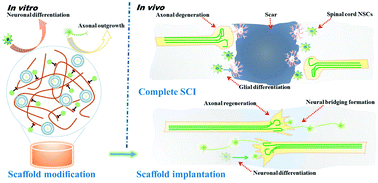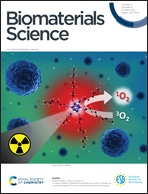Binary scaffold facilitates in situ regeneration of axons and neurons for complete spinal cord injury repair†
Abstract
The limited regrowth of transected axons and insufficient regeneration of lost neurons in adult mammals collectively hinder complete spinal cord injury (SCI) repair. Hence, designing an ideal bio-scaffold which could coordinate the regeneration of axons and neurons in situ might be able to effectively facilitate the reconstruction of neural circuits and the recovery of nerve function after complete SCI. In this study, a sponge-like collagen scaffold with good drug release characteristics and good nerve cell compatibility was prepared and used as a drug delivery platform. When doubly modified with Taxol liposomes and collagen-binding neurotrophic factor 3, the scaffold dually alleviated myelin-derived inhibition on neurite outgrowth of neurons and neuronal differentiation of neural stem cells in vitro. Meanwhile, the binary-drug modified scaffold was also able to simultaneously promote both axonal and neuronal regeneration when implanted into a complete transected SCI model. Additionally, the regenerated axons and neurons throughout the lesion site formed extensive synaptic connections. Finally, complete SCI rats that received binary scaffold implantation exhibited optimal neuroelectrophysiological recovery and hindlimb locomotor improvement. Taken together, implantation of the binary scaffold can establish neural bridging networks for functional recovery, representing a clinically promising strategy for complete SCI repair.



 Please wait while we load your content...
Please wait while we load your content...